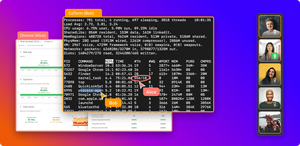Team standups are an essential part of the agile development process. They're brief, daily meetings that are meant to keep everyone on the team up to date on the progress of a project. These meetings are designed to help teams stay organized, focused, and on track to meet their goals. In this guide, we'll walk you through the basics of agile standups, how to conduct them effectively, and some tips for making them successful.
What is a standup?
An agile standup is a short, daily meeting where team members come together to share updates on the progress of their work. These meetings usually take place at the same time and in the same location every day, and they typically last between 10 and 15 minutes. During the standup, each team member gives a brief update on what they've accomplished since the last meeting, what they're currently working on, and what their plans are for the day ahead.
The purpose of the agile standup is to keep everyone on the team informed about what's going on with the project, identify any roadblocks or obstacles that need to be addressed, and ensure that everyone is working together to achieve the same goals. By holding these meetings daily, the team can stay organized, focused, and on track to meet their objectives.
How to conduct a great standup?
Here are some steps to follow when conducting an agile standup:
- Set a schedule: Determine a set time and location for the daily standup meeting. Make sure that everyone on the team is aware of the schedule and is available to attend.
- Define the agenda: Decide on the topics that will be covered during the meeting, such as what each team member accomplished since the last meeting, what they're currently working on, and what they plan to do next. Make sure that everyone on the team understands the agenda and knows what they're expected to discuss.
- Keep it brief: The standup meeting should be short and to the point. It's important to keep the meeting focused on the agenda and avoid getting sidetracked by unrelated topics.
- Encourage participation: Make sure that everyone on the team has an opportunity to speak during the meeting. Encourage team members to ask questions and provide feedback on each other's updates.
- Address roadblocks: If someone on the team is facing an obstacle or roadblock, make sure that it's addressed during the meeting. Encourage the team to work together to find a solution to the problem.
Common pitfalls in team standups
Like with any process, there are pitfalls to watch out for when doing team standups. Here are some common pitfalls to avoid:
- Losing focus: One of the most common pitfalls in Agile standups is losing focus. It's essential to keep the meeting short and focused, so team members don't get distracted by unrelated discussions. It's important to remind everyone to stick to the agenda and avoid going off-topic.
- Poor communication: Another pitfall is poor communication. It's essential to have an open and transparent communication style during standups. Everyone should be encouraged to share their progress, concerns, and blockers. It's important to listen actively and avoid interrupting others.
- Overloading with details: Another pitfall is overloading the meeting with unnecessary details. The standup should be brief and to the point, so team members can quickly update each other on their progress. It's important to avoid getting bogged down in too many details and stick to the critical information.
- Not prioritizing blockers: One of the main goals of standups is to identify and resolve blockers. However, sometimes team members may not prioritize their blockers or bring up issues that are not critical. It's important to encourage team members to prioritize their blockers and bring up critical issues during the meeting.
- Not following up: Finally, a common pitfall is not following up on the issues identified during the standup. It's important to document the blockers and action items discussed during the meeting and follow up on them promptly. Otherwise, the standup may become less effective over time.
Agile standups can be an effective way to stay on track and communicate effectively within a team and to avoid common pitfalls, team members should focus on staying on topic, communicating openly, keeping the meeting brief, prioritizing blockers, and following up on issues.
Tips for successful standups
Here are some tips for making your agile standups successful:
- Consistency: Make sure that the standup meeting takes place at the same time and location every day. This will help ensure that everyone on the team is available and prepared to participate.
- Focused: It's important to keep the standup meeting focused on the agenda and avoid getting sidetracked by unrelated topics. If someone raises an issue that needs to be addressed, make sure that it's addressed quickly so that the meeting can stay on track.
- Collaborative: Encourage team members to work together to solve problems and overcome obstacles. By fostering a collaborative environment, the team can work together to achieve their goals.
- Positive: Encourage team members to celebrate successes and acknowledge achievements during the meeting. This will help keep everyone motivated and focused on the project.
- Flexible: It's important to be flexible and adapt the standup meeting to the needs of the team. If something isn't working, be open to making changes and trying something new.
Conclusion
Agile standups are an essential part of the agile development process. Follow the steps above to make your standups effective and fun for the whole team.





